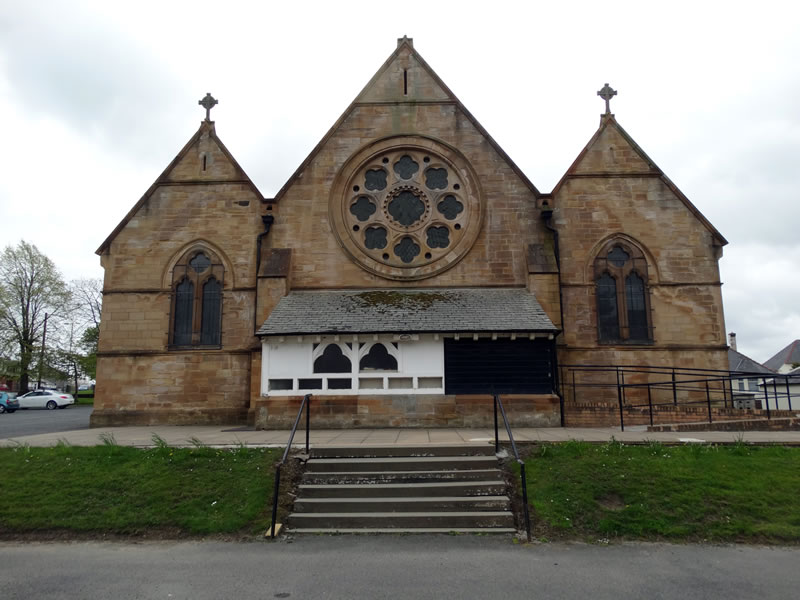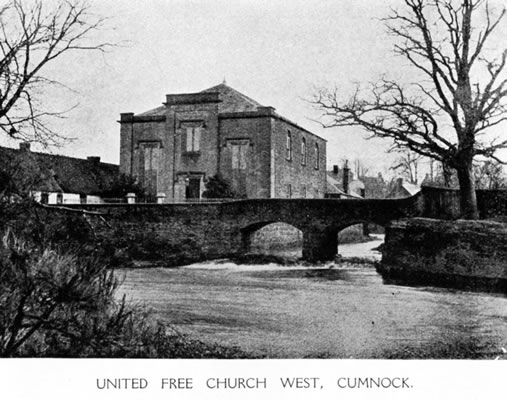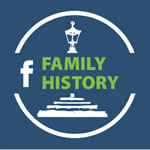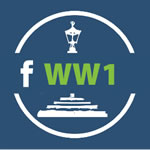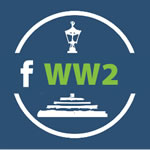Churches/Religious Institutions
For comprehensive information on the clergy who served these churches and institutions please see our Clergy page HERE
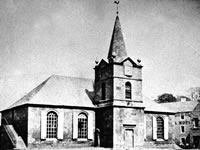 The Old Cumnock Parish Church was built in the 18th century - around 1754, replacing a much older church - and was designed by John and Robert Adam who were also working on Dumfries House. The Church could accommodate 700 people and was later enlarged about 1824 when the gallery stairs were erected. It was demolished c1864 to make way for the present larger church which was built to accommodate the growing population. In the days of the "Old" Parish Churches the graveyard was around the Church.
The Old Cumnock Parish Church was built in the 18th century - around 1754, replacing a much older church - and was designed by John and Robert Adam who were also working on Dumfries House. The Church could accommodate 700 people and was later enlarged about 1824 when the gallery stairs were erected. It was demolished c1864 to make way for the present larger church which was built to accommodate the growing population. In the days of the "Old" Parish Churches the graveyard was around the Church.
The building had an outside stair leading to a gallery, a belfry and steeple with weather cock. The ancient 'Jougs' for punishment were fastened to one gable end. The windows had wooden shutter to protect the glass from children playing handball against the walls.
The present church was opened on 17th November 1866.
For information on the Clergy who served the church please go HERE
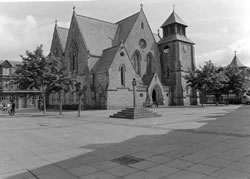 Cumnock Parish Church was erected between 1864 and 1866 in the Gothic style to the plans of James Maitland Wardrop of Edinburgh and opened on 17th November 1866. Yellow sandstone from Coalburn, near New Cumnock, was used. The cost of construction was £6,227 14s 8d though the proposed spire was not built, its intended location over the clock was capped off instead.
Cumnock Parish Church was erected between 1864 and 1866 in the Gothic style to the plans of James Maitland Wardrop of Edinburgh and opened on 17th November 1866. Yellow sandstone from Coalburn, near New Cumnock, was used. The cost of construction was £6,227 14s 8d though the proposed spire was not built, its intended location over the clock was capped off instead.
On the north side of the church is a Bute vault, with a gallery for the Marquis’s use inside the nave. There are some good examples of stained glasswork, some by Ballantyne from 1867, one window signed A L Moore, London.
A Brief Historical Sketch
It is believed that a place of worship has existed in the Square of Cumnock, which until recently was the commercial heart of the town, for over 100 years. However, the earliest historical record dates to 1275 when a tax of £16 Scots, was laid upon the Rectory of Cumnock. This sum was one tenth of the whole ecclesiastical revenue of the parish, for one year, and was to aid Henry III’s troops going on Crusade with Pope Innocent IV in 1254, but Cumnock didn’t pay until 1275.
The earliest recorded patrons of the church in Cumnock were the Earls of March. Existing with a rector, the rectory of Cumnock was converted into a prebend of the Cathedral of Glasgow in the 15th century, with the consent of the patron. The prebendary or canon of Glasgow Cathedral did not live in Cumnock and placed a vicar in situ to represent him.
As had other parishes in Scotland, Cumnock claimed a patron Saint; theirs being St. Conval, the son of an Irish Prince and disciple of St. Kentigern, popularly known as St. Mungo, after whom Glasgow Cathedral is named. It was to St. Conval that the church in Cumnock was dedicated. It may have been that as Cumnock was a prebend of Glasgow Cathedral its church was dedicated to a disciple of the Cathedral’s Saint. The connection remained until the reformation
At the Reformation John Dunbar, the priest in Cumnock, attached himself to the Reformed faith and became the first protestant minister of the parish, only to be succeeded by a formidable list of experienced and notable clergy.
The Rev. Ninian Bannatyne was presented to the parish of Cumnock by the Marquess of Bute on 10th February 1830 and ordained to the pastorate in September of that year. The Church of Scotland’s conflict with the State for freedom of the Church, resulted in the Disruption of 1843 when the minister of the parish, in conscience, resigned his position and emoluments as minister of the Church Established, and became minister of the Free Church in Old Cumnock. He also resigned the office of chaplain to the Marquess of Bute, the Lord High Commissioner to the General Assembly.
The vacancy was filled by Rev. James Murray, an assistant from Kirkconnel, in whose ministry the present building was erected as designed by James Maitland Wardrop of Edinburgh, and completed through the patronage of the Marquess of Bute in 1866. The Bute Gallery, or church loft, to seat the Butes, was never used as the family converted to the Roman Catholic faith.
The German designer Schultz executed small jobs for Lord Bute in and around Cumnock, including work in Dumfries House. In 1896 he prepared designs and working drawings for new chairs for the loft of the parish church and, in the same year, he designed shrines, which were made at Cardiff in consultation with Burges, for St. John’s Roman Catholic Church in Cumnock. The two chairs now sit in the Memorial Chapel of Old Cumnock Church.
The present church bell is not the original, but the bell in the vestibule of the church has an interesting history. It was cast by Quirinius de Vesscher of Rotterdam in 1697 and served in the two churches preceding the present Parish Church. During the 1860s, as a result of the demolition of the church built in 1754, the bell was hung on a tree at the foot of the Strand. Here it continued as Church and Town bell until the present bell was installed in the church. When the school was built in the 1870s, the bell transferred to it and was in position until fairly recently. De Vesscher bells are rare even in Holland and, as far as can be ascertained, only three definitely exist in Scotland: in Kirkcudbright, Kells and Cumnock. There is probably also an example in Kirkoswald. Expert opinion suggests that the casting is of the highest order and the hunting scene portrayed on the lower border is a masterpiece.
The first minister to be “called” to the parish church of Old Cumnock, by the congregation, was the Rev. J. Spence Robertson in 1875.
For the centenary celebrations of the “New” Church in 1966 the stonework was cleaned in and out; the pipe organ replaced by an electric one; the organ screen removed from the centre of the church, and re-sited to the side of the chancel. The screen was replaced by a mosaic commissioned by the Marquess of Bute, and designed by James Harrigan. It is based on Celtic manuscript figures, to retain a Scottish flavour to the work, and is a typical mosaic of the early Christian church.
On 20th November 1966 the early links of Cumnock parish with Glasgow Cathedral were renewed when Dr. Davidson of Glasgow Cathedral was invited by Dr. McClymont, the minister of the parish church of Cumnock, to dedicate the centenary memorial gifts “as a thanks offering by the congregation to Almighty God for a century of blessing and peace within these walls”.
Further links have been renewed since. One minister of the Old Church, Rev. George Muir, a Covenanter, was imprisoned due to his association with the covenanting movement, only to escape some time later. In acknowledgement of his steadfastness and his loyalty to the Kirk, Princeton University awarded him an honorary Doctorate Degree. In 1996 the Old Church re-established its link with Princeton Theological Seminary, in agreeing to accept seminarians in training for the Presbyterian ministry, over the summer months of each year, as part of their training in ministry.
In 1998 a Memorial Chapel was established in the Old Church in memory of those who, from within the parish and beyond, have had links and connections with the Old Church through the generations. A memorial book of names lies on the communion table of the Chapel. The Bute Hall in the church was one the burial crypt of the Bute family. The plaques around the wall identify the particular family members.
Old Cumnock Old Church was linked with Lugar Parish Church on 2nd April 1989. The first minister to be “called” to the linked charge is the present incumbent, Rev. John W. Paterson, inducted to the charge on 15th June 1994.
On 17th November 1995 Words of Wisdom, a shop and cafe, purchased by the Old Church, and converted by the hard work and dedication of men and women of the congregation, was opened. Situated in the Square, directly opposite the main entrance of the church, the shop serves tea/coffee and home baking, as well as being a source of Christian literature.
For information on the Clergy who served the church please go HERE
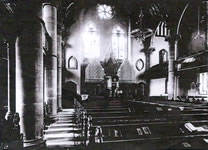 Cumnock Old Church stands proudly in the centre of the town, a focal point for its parishioners. Its predecessor, built in 1754, was in such a state of disrepair that the local landowner, the Marquess of Bute, was petitioned and a decision was made to rebuild. In 1864 demolition of the old building began. The weathercock was removed, and is now in the Baird Institute in Lugar Street, and the church bell was hung on the Bell Tree at the foot of the Strand. It continued as Church and Town bell, to be rung twice daily, until the tree became unsafe and had to be cut down. Eventually the bell was installed in the belfry of the school which was built in 1870. That same bell now occupies pride of place in the vestibule of the present church and is well worth inspecting. It was cast in Rotterdam in 1697, decorated with geometric designs and has a hunting scene around its border. De Vesscher bells are very rare, even in Holland, and only three exist in Scotland, the other two in Kirkcudbright and Kells. A plaque in the church tells the bell’s history.
Cumnock Old Church stands proudly in the centre of the town, a focal point for its parishioners. Its predecessor, built in 1754, was in such a state of disrepair that the local landowner, the Marquess of Bute, was petitioned and a decision was made to rebuild. In 1864 demolition of the old building began. The weathercock was removed, and is now in the Baird Institute in Lugar Street, and the church bell was hung on the Bell Tree at the foot of the Strand. It continued as Church and Town bell, to be rung twice daily, until the tree became unsafe and had to be cut down. Eventually the bell was installed in the belfry of the school which was built in 1870. That same bell now occupies pride of place in the vestibule of the present church and is well worth inspecting. It was cast in Rotterdam in 1697, decorated with geometric designs and has a hunting scene around its border. De Vesscher bells are very rare, even in Holland, and only three exist in Scotland, the other two in Kirkcudbright and Kells. A plaque in the church tells the bell’s history.
On 23rd August 1864, the foundation stone of the present church was laid. The building cost £6,227 and opened its doors on 15th November 1866 with seating for 1100 parishioners. It features gallery for the Marquess of Bute and family as patron of the parish. The Bute family never used the gallery as they converted to the Roman Catholic faith.
On entering the main door, there are two round blue glass windows, one on either side. These windows were presented by the Women’s Guild in their centenary year – 1987. Access to the church knave is through two glass-panelled doors – the Faith door and the Love door, which depict the sacrament of Holy Baptism and the constancy of God’s love.
Unusually, the pews face the visitor. Right at the far end of the church, looking down from above is the Bute Gallery with the WWI and WWII memorials underneath. On the wall of the Bute Gallery there is a cloth embroidered with the names of all the members of the church from 100 years earlier. Through the back door is the Bute Hall which was once the burial crypt of the Bute family. Around the walls are plaques commemorating those members of the Bute family buried there. There is also a photograph of the church as it once looked before the railings around it were sacrificed for the war effort.
Re-entering the church, facing us on high are the two magnificent stained glass windows over the main door. These were presented by the Marquess of Bute when the church was built. Underneath are the pulpit, the communion table and chairs, the baptismal font and the eye-catching mosaic mural depicting the story told in Matthew Chapter 14 verses 22-32 of Jesus walking on the water and reaching out to rescue Peter. The figure of Jesus with the eleven disciples safely held in the shape of his cloak represents the safety of a boat.
To the left of the pulpit is the library with a large glass-topped table. Under the glass is a table cover on which the church members signed their names which were then outlined in delicate embroidery. This was completed as a Millennium Project.
In the four corners of the table cover are the name and dates of the four previous serving ministers.
Rev. J. Spence Robertson 1875-1927.
Rev. Douglas McClymont 1927-1971.
Rev. James Ferguson 1972-1984.
Rev. Martin McKean 1984-1993.
The present charismatic minister is Rev. John Paterson, a popular figure in the church and within the wider community.
Resting on the table top are photos of the two Indian children currently sponsored by the church – Sandra McFarlane and Abinash. On the side wall are the Skares WWI Memorial and the bell for Skares School.
On the opposite side of the church is the small Memorial Chapel with its communion table on which rests a book commemorating friends and members of the Old Church who have died. In the chapel are two chairs, each with the Bute crest, brought down from the Bute Gallery. Before each chair is a kneeler covered in beautiful tapestry.
Access to the upstairs pews is by staircases on either side of the entrance hall. From there, is a fine view of the knave and also the beautiful commemorative stained glass windows gifted by families in memory of loved ones
Archibald Breckenridge, solicitor, for his wife.
Herbert Morton, former owner of the picture house, for his wife.
The Kerr family window with its exquisite detail.
The Boswell crest in memory of Patrick Boswell of Garallan.
From upstairs, a closer view of the Bute Gallery can be seen, and another view of the stained glass windows above the main door.
On the way downstairs, the intrepid visitor might be tempted to climb the vertical wooden ladder leading to the clock tower, where the clock is wound weekly so that citizens of Cumnock may know the time. The original clock was presented in 1872 by Captain William Allason Cunningham of Logan and Afton and cost 100 guineas.
Cumnock Old Church is steeped in history yet is living testimony to the many people who have worshipped there and have left their mark in the legacies they have bequeathed to the generations still to come.
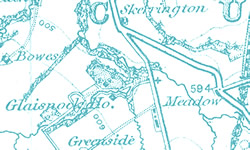 All Saints Church was situated across the road from Glaisnock House. It was originally of the Episcopal denomination - but later its services were conducted by the minister of the Congregational Church. The Church has long been demolished.
All Saints Church was situated across the road from Glaisnock House. It was originally of the Episcopal denomination - but later its services were conducted by the minister of the Congregational Church. The Church has long been demolished.
In 1876 two members of Kilmarnock`s Baptist Church came to reside in Gasswater - not far from Cumnock - and the first meetings were held there. The village meetings continued for six months and then the meeting place was changed to Cumnock - thus Cumnock`s Baptist Church came into being.
After meetings in a variety of halls for a number of years, a decision was taken to erect a church building, and the present church in Barrhill Road was built in c1886 with seating for 200. The manse was purchased in 1919 and in the early 1930s the church was extended by the addition of a hall, vestry, and ladies` room all of which are in constant use at the present day. The front porch dates from the 1970s.
 The Congregationalists first met in 1838 in a hall in the Black Bull Hotel, later moving in 1847 to a Chapel in the Square converted from the Old Parish School.
The Congregationalists first met in 1838 in a hall in the Black Bull Hotel, later moving in 1847 to a Chapel in the Square converted from the Old Parish School.
It was not until 1882 that the Congregationalists had their own church built across the Lugar Bridge in what was then still part of Auchinleck Parish. The Congregational Church cost £2,100 and had seating for 350 people. The church was designed by John Murdoch of Ayr and opened on 18th February 1883, the church is situated at Stepends on the north side of Stepends Bridge.
A noteworthy member of early congregation of this Church was James Keir Hardie but his association was short lived. In March 1884, together with the pastor and 37 members, he resigned and set up a separate congregation attached to the Evangelical Union.
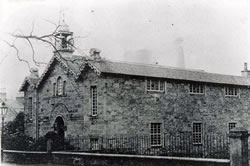 At the Disruption in 1843, the Rev. Ninian Bannatyne and many of his congregation left the Parish Church and formed the Free Church. Within a short period they built the Free Church in Ayr Road, complete with school and manse, which opened for worship in October 1843. It remained in use until the summer of 1896 when it was demolished and work began to build the Crichton Church
At the Disruption in 1843, the Rev. Ninian Bannatyne and many of his congregation left the Parish Church and formed the Free Church. Within a short period they built the Free Church in Ayr Road, complete with school and manse, which opened for worship in October 1843. It remained in use until the summer of 1896 when it was demolished and work began to build the Crichton Church
Ninian Bannatyne died in 1874, he was followed as minister by Rev. Alexander Adamson and Rev. John Warrick who was ordained on 22nd February 1883. Rev. Warrick wrote History of Old Cumnock published in 1899.
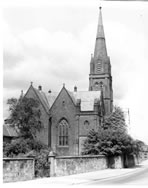 Erected in Cumnock`s Ayr Road between 1896 and 1899, the Crichton Church was paid for by Miss Crichton of Hillside in memory of her father Hew Crichton and her brother Sheriff James Arthur Crichton who died within days of each other in 1892.
Erected in Cumnock`s Ayr Road between 1896 and 1899, the Crichton Church was paid for by Miss Crichton of Hillside in memory of her father Hew Crichton and her brother Sheriff James Arthur Crichton who died within days of each other in 1892.
The Church, with its seating capacity of 500, is built of red sandstone in decorated Victorian Gothic design. The spire stands 140 feet tall and can be seen for miles around. A capsule containing news and mementos of the time is said to be buried under the large front step at the entrance to the front door.
The first minister in charge of this new Free Church was Reverend John Warrick who served the Free Church from 1883 until his death in 1931.
From the Scotsman 28 July 1897
NEW FREE CHURCH AT CUMNOCK
 The memorial stone of the new Free Church which is being built at Cumnock by the Miss Crichton of Hillside was laid yesterday The Reverend Mr Warrick presided. The service began with Mr Warrick briefly narrating the history of the former church and paid a warm compliment to Miss Crichton for providing the funds. He concluded by calling on Miss Crichton to place a sealed bottle in the cavity of a stone underneath the threshold, which she did, Mrs Warrick placing beside it the bottle taken out of the foundation of the old church. In commemoration of the occasion, Mr Menzies, of Edinburgh, the architect, presented Miss Crichton with a silver trowel, and Provost Richmond presented Mrs Warrick with a mallet made from the wood of the old church.
The memorial stone of the new Free Church which is being built at Cumnock by the Miss Crichton of Hillside was laid yesterday The Reverend Mr Warrick presided. The service began with Mr Warrick briefly narrating the history of the former church and paid a warm compliment to Miss Crichton for providing the funds. He concluded by calling on Miss Crichton to place a sealed bottle in the cavity of a stone underneath the threshold, which she did, Mrs Warrick placing beside it the bottle taken out of the foundation of the old church. In commemoration of the occasion, Mr Menzies, of Edinburgh, the architect, presented Miss Crichton with a silver trowel, and Provost Richmond presented Mrs Warrick with a mallet made from the wood of the old church.
For information on the Clergy who served the church please go HERE
On the left-hand side of Glaisnock Street you will find a small church set back from the road. Generally speaking most people complain that churches are cold places, but we cannot say this of St. Andrew`s Church as it is a comfortable and well appointed building. When winter holds the town in an icy grip the warm church is much appreciated.
St. Andrew`s United Free Church was constituted in 1929 mainly by a minority from the West United Free Church which was situated in the Tanyard and known locally as the "Box" Church because of its square shape (It is now the Box Cafe).
The United Free Church of that era re-joined the Church of Scotland - but there were people who would not re-join the Church of Scotland because of certain principles and they wished to remain as Free Church members. They met in the Cumnock`s Lesser Town Hall until 3rd June 1939 when the St Andrew`s Church was opened. It was designed and built by Donald MacDonald. The Church was re-dedicated as St. Andrew`s Free Church of Scotland on 7th June 1959 after interior alterations
There was a small hall too for the various organisations to meet. However, c1980 a school room in Catrine became available and the church applied for it. The conditions were that the church could have the building but had to dis-assemble it and transport it themselves. This was done by an eager and willing group of men (including the minister of the time). A lot of hard work was put into re-assemble the building at the back of the church - however it was worthwhile and the lovely hall is used to this day.
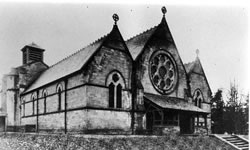 In 1882, the 3rd Marquess of Bute gave financial assistance towards the erection of St. John`s Church - at the head of Glaisnock Street - as a place of worship for Roman Catholics who had previously worshipped at Birnieknowe in Auchinleck Parish. The designer of the building was William Burges who was noted for his work at Cardiff Castle and Cork Cathedral. In 1885 St John’s was the first Church in the country to install electricity using a generator. The Manse or Presbytery was erected in 1913 for the Parish Priest Rev Martin Meagher (pronounced Marr).
In 1882, the 3rd Marquess of Bute gave financial assistance towards the erection of St. John`s Church - at the head of Glaisnock Street - as a place of worship for Roman Catholics who had previously worshipped at Birnieknowe in Auchinleck Parish. The designer of the building was William Burges who was noted for his work at Cardiff Castle and Cork Cathedral. In 1885 St John’s was the first Church in the country to install electricity using a generator. The Manse or Presbytery was erected in 1913 for the Parish Priest Rev Martin Meagher (pronounced Marr).
Father Meagher was later raised to the Cathedral Chapter and received the title Canon. He served St John’s parish from 1906 – 1936, and in 1971 one of the streets in the new estate, Barshare, was named Meagher Court – it too is pronounced Marr.
The stained glass windows in the Church date from 1884 and were the work of N. J. Westlake who also designed the Bute window (1883) which was erected to John, Lord Bute by a grateful congregation. This window illustrates St Ninian over the Bute Arms.
In 1960 the altar, font, tabernacle plinth and pulpit were replaced with modern stone carved from white Creetown granite. The organ of the Church is one of the finest in the town. The painting on the ceiling of the sanctuary was done by an Italian artist who was brought over from Italy especially to do the painting.
Saint John the Evangelist, Roman Catholic Church
by Madge MacMillan
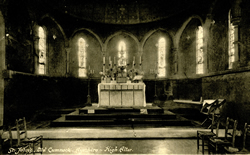 In 1882 the above church was built for the Catholics of Cumnock. It was a gift from the third Marquess of Bute to commemorate the birth of his son, Ninian. The designer of the building was William Burges who was noted for his work at Cardiff Castle and Cork Cathedral.
In 1882 the above church was built for the Catholics of Cumnock. It was a gift from the third Marquess of Bute to commemorate the birth of his son, Ninian. The designer of the building was William Burges who was noted for his work at Cardiff Castle and Cork Cathedral.
In 1885 electricity was installed in St. John’s and this was the first church in the country to be lit by electricity.
The stained glass windows in the sanctuary date from 1884 and were the work of N.J. Westlake. There are 8 windows arranged in a semi circle of the following: John the Baptist; Mary; Christ the King; John the Evangelist; St. Joseph; St. James; St. Peter and St. Paul. Westlake also designed the Bute window which was installed as a gift to the Marquess by the congregation in 1883 to express their gratitude for the gift of the beautiful church.
The seating capacity of the church is about 330. Long wooden benches now replace the original single wicker chairs.
In 1960 the pulpit, altar rails, altar and Baptismal font were replaced with modern stone carved from white Creetown granite. Above the Sanctuary is a painting of The Last Supper which was painted by an artist who was brought over from Italy specially to do this. To the left of Sanctuary is a small altar dedicated to St. Andrew. This altar is also enhanced with a painting of St. Columba, St. Andrew and St Margaret.
There are fourteen stations of the Cross placed around the walls between the windows to illustrate the journey of Jesus to Calvary. These plaques were donated by fourteen parishioners whose names are inscribed on the bottom of each plaque. The organ which is placed in the sanctuary was installed in 1884. Shortly after that the Bishop of Argyll paid a visit to Dumfries House as a guest of the Marquess. The Bishop was so impressed by the beautiful organ and the choir of miners that after expressing his gratitude to the Marquess, he, the Marquess had a cathedral built in Oban for the Argyll diocese.
The grounds of St. John’s church were at one time surrounded by beautiful trees, but in the 1960’s the then Parish Priest got permission from the Marquess at that time to have the trees chopped down to make way for a car park as most people had by cars then.
There are still a number of trees surrounding the church and the presbytery.
A gallery of the church today with the beautiful painted ceiling, murals and stained glass.
St. Ninian`s Church in Netherthird came into being approx. 50 years ago with the laying of the foundation stone taking place on Wednesday 12th May 1954. The foundation stone was laid in place by Commander G. H. Hughes-Onslow, D.S.C. who at that time was the Lord Lieutenant of Ayrshire.
The first minister was Rev. Robert M. Brown whose induction service took place in the Cumnock Parish Church on Wednesday 2nd June 1954. He conducted his first service at Netherthird on 19th September 1954 and the attendance was approx. 50 people. The first manse was situated at 79 Cairnscadden Road, Craigens.
The Church in its present location was officially opened on Friday 24th June 1955 - the dedication ceremony being performed by the Very Rev. Professor J. Pitt-Watson D.D., a former moderator of the Church of Scotland. The attendance at the ceremony was approx. 400 people.
Rev. Brown left in 1957 to be replaced on 27th March 1958 by Rev. Hamish MacIntosh, from Lamlash. On 20th December 1961, the third minister Rev. Ian Tweedlie was inducted and around this time St. Ninian`s was linked with the charge at Lugar Parish Church. Rev. Tweedlie remained as minister for 27 years until his death on Wednesday 27th July 1988. As a result of the vacancy a readjustment of the churches took place - with Lugar being linked with Cumnock Parish Church and St. Ninian`s being linked with the Crichton West Church. As a result the new minister was the Rev. Effie Campbell, minister of Crichton West. The linkage took place on 7th May 1989 and Rev. Campbell ministered to the congregation for two years until her retiral as a minister on 1st June 1991. The induction of the present minister Rev. Duncan Campbell Eddie took place in Crichton West Church. The present minister is the Rev. John C. Christie
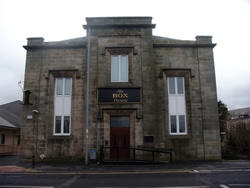 The history of the United Presbyterian Church in Cumnock takes us back to the 1770s. In the second half of that century, a watchmaker, named Rankin, came from Glasgow to settle in the town. He belonged to the Secession Church, and when he came to Cumnock he found no sympathy in the Established Church, for in those days the points of difference in Church government were hotly contested on both sides. Rankin was a man of strong convictions and individuality, and he soon he gathered about him a group of like-minded people. The result was that he and his friends found themselves able to apply to the Burgher Presbytery of Glasgow for a regular supply of preachers. This application was granted in 1773, and preachers were sent for two Sundays in each month. At first they met in the open air and two years later the little congregation resolved to take the important step of building a church.
The history of the United Presbyterian Church in Cumnock takes us back to the 1770s. In the second half of that century, a watchmaker, named Rankin, came from Glasgow to settle in the town. He belonged to the Secession Church, and when he came to Cumnock he found no sympathy in the Established Church, for in those days the points of difference in Church government were hotly contested on both sides. Rankin was a man of strong convictions and individuality, and he soon he gathered about him a group of like-minded people. The result was that he and his friends found themselves able to apply to the Burgher Presbytery of Glasgow for a regular supply of preachers. This application was granted in 1773, and preachers were sent for two Sundays in each month. At first they met in the open air and two years later the little congregation resolved to take the important step of building a church.
Dissenters were very unpopular, especially with landlords and those in authority and it was impossible to obtain a site from any of the large landowners of the district but a private individual granted a feu near the meeting of the Lugar and the Glaisnock at the Dub where the Church building still stands (the Box Café), the direct descendant of the first church. The feu was gladly accepted, the foundation for the church was cleared, a member gave stone, and even lime was promised, and all that was needed in order to proceed with the building was a supply of sand to mix with the lime. But no one including the Earl of Dumfries would supply the sand for the erection of the church. The Matters were at a standstill, and those who sneered at the Dissenters enjoyed the dilemma.
This turn of events was regarded as a huge joke and the subject of much fun and gossip. Things looked very black for the Dissenters. If they been a rich body they would not have cared whether their neighbours envied or pitied them; but being poor, they could not afford to bring the sand from any considerable distance.
One night a great storm broke over Cumnock and rain fell in torrents, lightning flashed constantly, and the loud roar of the thunder could be heard some distance away. The storm passed with the night, and in the morning, the Glaisnock had come down in flood, overflowing its banks and covered the foundations of the church to the top with a sufficient quantity of sand to enable the builder to finish his work. They built their church in 1775, the earliest Nonconformist Church in the town.
This small Church was replaced in 1831 by a substantial and comfortable building, which was referred to as a Box Church because of its shape. It was large, airy, and comfortable, with good acoustics and could seat about nine hundred. It cost £876 11s and Tradesmen included Andrew Murdoch and J. Nimmo, masons, David Kier, slater, William Black and William MacLetchie, wrights, Hugh Maitlen, plasterer and William Thomson, plumber. The windows were of stained glass with a geometrical pattern, those behind the pulpit being especially fine.
In 1847 it became United Presbyterian. In 1900 - due to churches amalgamating - it became the Cumnock United Free Church, West. Cumnock had another United Free Church in the Crichton Church. Both United Free Churches became Parish Churches in 1929 and Cumnock United Free Church, West now houses a café, the Box cafe, after being a Council storage facility and lay derelict for some time. It is the oldest church building left in Cumnock. The building is again up for rent or sale.
This small church was converted from a former engine house in 1867 and is situated in the small village of Lugar just outside Cumnock. The parish was disjoined from Auchinleck and became a Quoad Sacra parish by the Court of Teinds on 8th March 1907. The church was then linked to Netherthird and then Cumnock in 1968, then the link changed to Cumnock Old Church in the Square in 1988. The church was broken into in 1990 and some valuable silver stolen.
Bute Hospital or Lady Bute's Hospital in Barrhill Road was the gift of Lady Bute in 1882. It was staffed by nurses from the Sisters of the Sacred Heart and had 10 beds and 3 cots. It was used for all types of medical work and was often used for the treatment of victims of mining accidents. It was closed in 1950 at the formation of the National Health Service and became the Sisters of the Sacred Heart convent but was eventually demolished in mid 1977 and replaced by the houses development at Murray Court.

